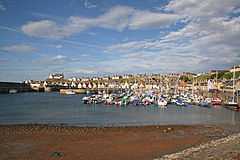Findochty
| Findochty | |
| Scottish Gaelic: Am Fionn Ochdamh | |
| Scots: Finichty | |
 Findochty Harbour, with town in background |
|
 Findochty | |
| Population | 1,106 [1] |
|---|---|
| OS grid reference | NJ4667 |
| Civil parish | Rathven |
| Council area | Moray |
| Lieutenancy area | Banffshire |
| Country | Scotland |
| Sovereign state | United Kingdom |
| Post town | BUCKIE |
| Postcode district | AB56 |
| Dialling code | 01542 |
| Police | Scottish |
| Fire | Scottish |
| Ambulance | Scottish |
| EU Parliament | Scotland |
| UK Parliament | Moray |
| Scottish Parliament | Banffshire and Buchan Coast |
Findochty (pronounced: /ˈfɪnɛxti/, Scots: Finichty,[2] Scottish Gaelic: Am Fionn Ochdamh) is a village in Moray, Scotland, 4 miles east of the town of Buckie. In 1568 the Ord family acquired the manor, port, custom and fishers' lands of Findochty, and later built Findochty Castle, now a ruin, which stands to the west of the village. In 1716 the Ords brought 13 men and 4 boys from Fraserburgh under contract to fish from Findochty, and for a time the harbour was busy with landings of herring and white fish. Findochty expanded as a fishing port through the 1700s and 1800s, and by 1850 was home to 140 fishing boats. But the expansion in the late 1800s of nearby Buckie provided a better harbour, and the fishing fleet had left Findochty by 1890. Findochty harbour is now used mostly by pleasure craft and is a good sun spot when the tide is out. A local artist, Correna Cowie created a statue of a seated fisherman who watches over the harbour.
Findochty stands on the shores of the Moray Firth. The Gaelic name of the village was recorded by Diack in his own transcription method as fanna-guchti which is unclear in meaning. With its painted cottages, a scenic harbour overlooked at the west by the local war memorial, and at the east by the white painted Church of Scotland, Findochty is a jewel of the north east of Scotland.
The village has basic amenities including a pub, a small supermarket and a pharmacy. There is a caravan site at the west of the village, situated behind The Admirals pub. The caravan park looks out onto a rock formation known as the Edindoune and a bay past which the schools of Moray Firth dolphins can sometimes be seen. For sailors, there is a marina and pontoons. The harbour is well protected from the elements by sturdy quays, one of which is topped with a small lighthouse.
In 1899, prehistoric animal bones taken to be made into implements, were discovered in a cave in the cliff near the present bowling green. Horn spoons and needles without eyes and even a broken lignite armlet were found. The bones were dated around 100 BC, but sadly they have since been lost. The cave was blasted and used for rock to build houses and roads, making way for progress during the Industrial Revolution.
To the East of the village the cliffs rise toward Tronach Head, honeycombed with caves and inlets. Clifftop paths link Findochty with the neighbouring village of Portknockie and West to Strathlene on the outskirts of Buckie in the other direction.
The cliffs are the home to myriad seabirds. There are substantial rock formations such as the Priest Craigs, and the Horses Head. West of the village lies the 18 hole Strathlene golf course, bounded to the north by coastal footpaths and low cliffs, making the errant drive from some tees particularly costly. At the south side of the course lies the road linking Findochty to Portessie and Strathlene. Adjacent to this can be seen the remains of Findochty castle. Access to the castle is not normally permitted as it is located in the midst of a working farm.
Many of the villagers work in the oil and gas industry - as is true of much of the surrounding area - due to its reasonable proximity to Aberdeen.
Churches
There are a number of churches in this small village, a Church of Scotland congregation. The Salvation Army have an active corps here and the 'Closed' Plymouth Brethren have two meeting rooms as their church halls are generally known. There is also a Methodist church. The Plymouth Brethren at Station Road Hall have an annual Bible Conference every September which draws Christians from all parts of the British Isles and many overseas countries. Details of this are found on the BibleCentre website .
References
External links
- Panorama from Findochty Pier (QuickTime required)
- grid reference NJ465685
| |||||||
